Get free scan and check if your device is infected.
Remove it nowTo use full-featured product, you have to purchase a license for Combo Cleaner. Seven days free trial available. Combo Cleaner is owned and operated by RCS LT, the parent company of PCRisk.com.
What kind of malware is Eternidade?
Eternidade is a malicious program written in the Delphi programming language. It is a stealer and banking trojan capable of extracting sensitive data from infected devices. Eternidade has been used to target users in Brazil. This malware can self-spread through WhatsApp spam.

Eternidade malware overview
Eternidade is a stealer that aims to extract and exfiltrate financial information. At the time of writing, this malware is spread through spam delivered via the WhatsApp messaging platform. Proliferating messages are in Brazilian Portuguese. These messages include a malicious script that triggers Eternidade's infection chain.
Upon execution, the script drops a batch file designed to infiltrate a WhatsApp worm and a dropper. The former is used to spread Eternidade via the aforementioned WhatsApp spam. This worm collects victims' WhatsApp contact lists, including contact status (saved/unsaved), WhatsApp IDs, contact names, and phone numbers. The gathered data is immediately sent to the attackers' C&C (Command and Control) server.
The malware then uses the extracted information to craft personalized messages and send them to all contacts. The recipients' names are included in these messages, and an appropriate greeting is chosen based on the time of the day (i.e., "bom dia", "boa tarde", "boa noite"). This spam includes the malicious script, and a following message is delivered. However, it is worth noting that the text and language of the messages can be changed by the attackers remotely. Hence, variations are possible.
The latter – the dropper checks the system language and does not complete the infection if it is not Brazilian Portuguese. If the language does not match, an error message is displayed.
If the infection proceeds, several payloads are introduced into the system. The malware collects extensive device data, i.e., device name, OS version and architecture, hardware details, total available disk space, RAM (extrapolated), IP address, date/time, etc. The infection utilizes anti-detection mechanisms, such as checking the system for installed antivirus software. Payloads are run in-memory, and an injector trojan is used to inject the final payload – Eternidade.
This stealer targets various banking, payment service, and cryptocurrency-related applications (full list below). If a target is identified, the malware establishes a connection with its C&C server. It is noteworthy that while Eternidade does have a hardcoded C&C address – it is a backup. The actual C&C server is accessed via email, the log-in credentials of which are hardcoded into the stealer. Thus, the malware can maintain persistence and continuously update the C&C address.
Eternidade can retrieve appropriate phishing screens, which are used to overlay genuine applications. These overlays record entered information – like log-in credentials. However, the stealer has other data-stealing abilities, such as exfiltrating files, taking screenshots, and keylogging (recoding keystrokes).
It must be mentioned that malware developers often improve upon their tools and methodologies. Therefore, Eternidade, which already has several variants, is likely to have additional/different features in potential future iterations.
To summarize, the presence of software like the Eternidade stealer on devices can result in severe privacy issues, financial losses, and identity theft.
| Name | Eternidade malware |
| Threat Type | Trojan, banking trojan, banking malware, password-stealing virus, stealer. |
| Detection Names | Avast (Win32:MalwareX-gen [Trj]), Kaspersky (HEUR:Trojan.Win32.Agent.gen), Microsoft (Trojan:Win32/Wacatac.B!ml), Symantec (Trojan.Gen.MBT), TrendMicro (Trojan.Win32.CASBANEIRO.YAFKU), Full List Of Detections (VirusTotal) |
| Symptoms | Trojans are designed to stealthily infiltrate the victim's computer and remain silent, and thus no particular symptoms are clearly visible on an infected machine. |
| Distribution methods | Infected email attachments, malicious online advertisements, social engineering, software 'cracks'. |
| Damage | Stolen passwords and banking information, identity theft, the victim's computer added to a botnet. |
| Malware Removal (Windows) |
To eliminate possible malware infections, scan your computer with legitimate antivirus software. Our security researchers recommend using Combo Cleaner. Download Combo CleanerTo use full-featured product, you have to purchase a license for Combo Cleaner. 7 days free trial available. Combo Cleaner is owned and operated by RCS LT, the parent company of PCRisk.com. |
Banking malware examples
We have investigated countless malicious programs; Maverick, SORVEPOTEL, and BlackMoon are merely a few of our newest articles on banking trojans. Malware does not necessarily target only financial details but can seek a wide variety of information. Many malware types possess data-stealing capabilities, and/or they are used with other kinds of malicious software.
However, regardless of what (if any) information malware targets – its presence on a system remains a threat to device and user safety. Therefore, all threats must be removed immediately upon detection.
How did Eternidade infiltrate my computer?
As detailed in the article above, Eternidade has been observed self-spreading through WhatsApp spam. During this stealer's infection process, a WhatsApp worm is introduced into victims' systems. The worm malware gathers WhatsApp contact data and uses it to send personalized messages. The spam includes a malicious script that triggers the Eternidade's infection chain on recipients' devices.
Other distribution methods are not unlikely. Social engineering and phishing are standard in malware proliferation. Malicious software is often disguised as or bundled with ordinary content.
Infectious files come in various formats, such as executables (EXE, RUN, etc.), archives (RAR, ZIP, etc.), documents (PDF, Microsoft Office, Microsoft OneNote, etc.), JavaScript, and so on. Merely opening a malicious file can be enough to trigger the infection chain.
The most widespread distribution techniques include: backdoor/loader-type trojans, suspicious download sources (e.g., freeware and third-party websites, Peer-to-Peer sharing networks, etc.), drive-by (stealthy/deceptive) downloads, malicious attachments or links in spam emails/messages, online scams, malvertising, illegal software activation tools ("cracks"), and fake updates.
Furthermore, some malicious programs can self-proliferate through local networks and removable storage devices (e.g., external hard drives, USB flash drives, etc.).
How to avoid installation of malware?
We highly recommend downloading only from official and trustworthy channels. Activate and update software using functions/tools provided by legitimate developers, as those obtained from third-parties can contain malware.
Another recommendation is to be cautious when browsing since the Internet is rife with deceptive and dangerous content. Incoming emails and other messages must be approached with care. Attachments or links present in dubious/irrelevant mail must not be opened, as they can be infectious.
It is essential to have a dependable antivirus installed and kept up-to-date. Security programs must be used to run regular system scans and to remove detected threats and issues. If you believe that your computer is already infected, we recommend running a scan with Combo Cleaner Antivirus for Windows to automatically eliminate infiltrated malware.
Screenshot of an overlay displayed by Eternidade (image source – Trustwave):
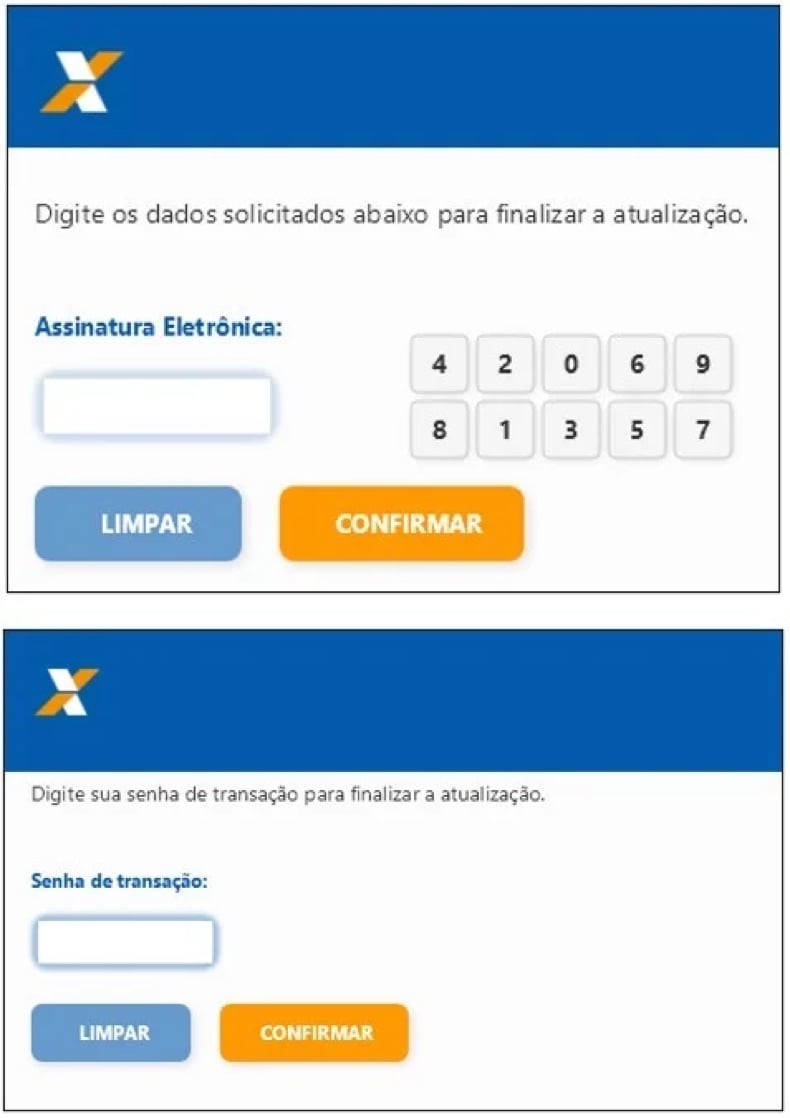
Screenshot of Eternidade's admin panel (image source – Trustwave):
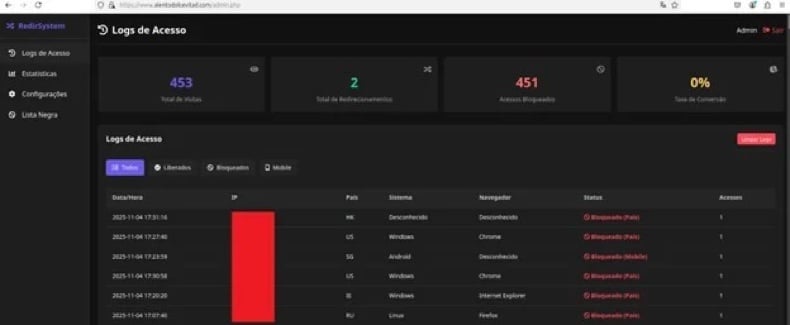
Banks targeted by Eternidade stealer:
- Banco BMG
- Banco Bradesco
- Banco BS2
- Banco da Amazônia
- Banco do Brasil
- Banco do Nordeste (BNB)
- Banrisul
- BTG Pactual
- Caixa Econômica Federal (Caixa, CEF)
- Itaú Unibanco
- Mercantil Banco
- Santander Bank
- Sicoob
- Sicredi
- Tribanco
Targeted payment services:
- MercadoPago
- RecargaPay
- Stripe
Targeted cryptocurrency wallets:
- Atomic
- Blockchain.com
- Coinomi
- Electrum
- Exodus
- Ledger
- Math
- MetaMask
- Phantom
- Solflare
- TokenPocket
- Trust
Targeted cryptocurrency exchanges:
- Binance
- Bitfinex
- Bitget
- Bitstamp
- Bybit
- Coinbase
- Coinext
- Crypto.com
- Foxbit
- Gate.io
- Gemini
- Huobi
- Kraken
- Kucoin
- Novadax
- OKX
- Poloniex
Instant automatic malware removal:
Manual threat removal might be a lengthy and complicated process that requires advanced IT skills. Combo Cleaner is a professional automatic malware removal tool that is recommended to get rid of malware. Download it by clicking the button below:
DOWNLOAD Combo CleanerBy downloading any software listed on this website you agree to our Privacy Policy and Terms of Use. To use full-featured product, you have to purchase a license for Combo Cleaner. 7 days free trial available. Combo Cleaner is owned and operated by RCS LT, the parent company of PCRisk.com.
Quick menu:
- What is Eternidade?
- STEP 1. Manual removal of Eternidade malware.
- STEP 2. Check if your computer is clean.
How to remove malware manually?
Manual malware removal is a complicated task - usually it is best to allow antivirus or anti-malware programs to do this automatically. To remove this malware we recommend using Combo Cleaner Antivirus for Windows.
If you wish to remove malware manually, the first step is to identify the name of the malware that you are trying to remove. Here is an example of a suspicious program running on a user's computer:
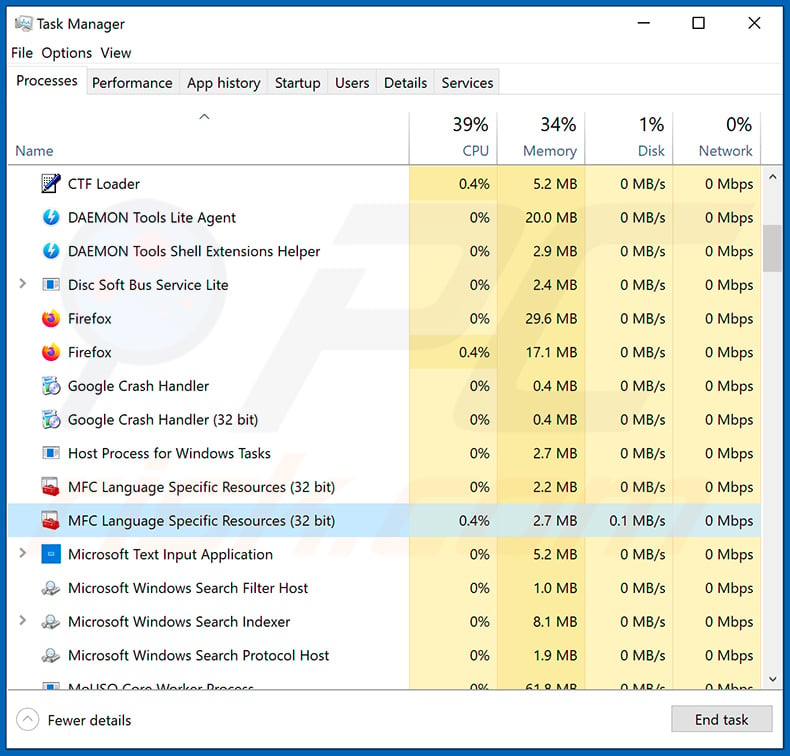
If you checked the list of programs running on your computer, for example, using task manager, and identified a program that looks suspicious, you should continue with these steps:
 Download a program called Autoruns. This program shows auto-start applications, Registry, and file system locations:
Download a program called Autoruns. This program shows auto-start applications, Registry, and file system locations:
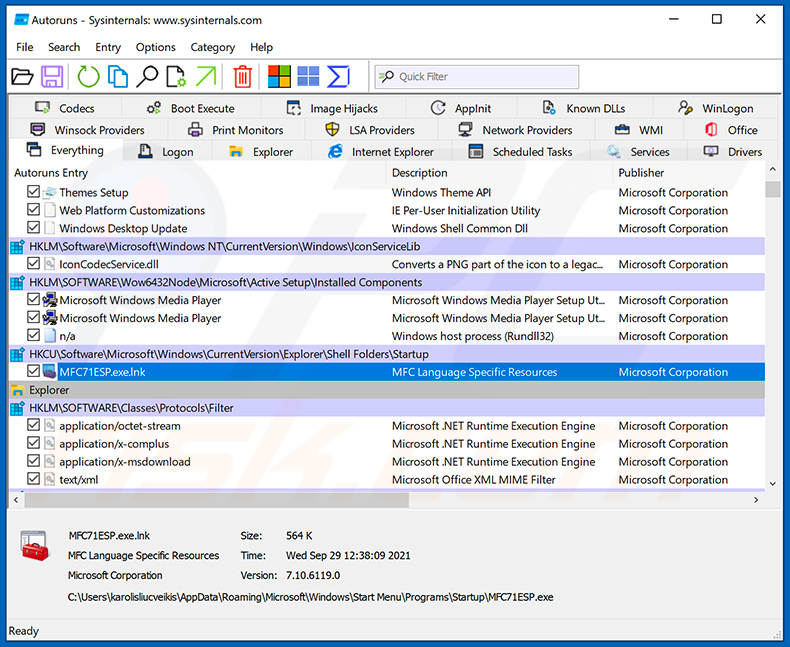
 Restart your computer into Safe Mode:
Restart your computer into Safe Mode:
Windows XP and Windows 7 users: Start your computer in Safe Mode. Click Start, click Shut Down, click Restart, click OK. During your computer start process, press the F8 key on your keyboard multiple times until you see the Windows Advanced Option menu, and then select Safe Mode with Networking from the list.
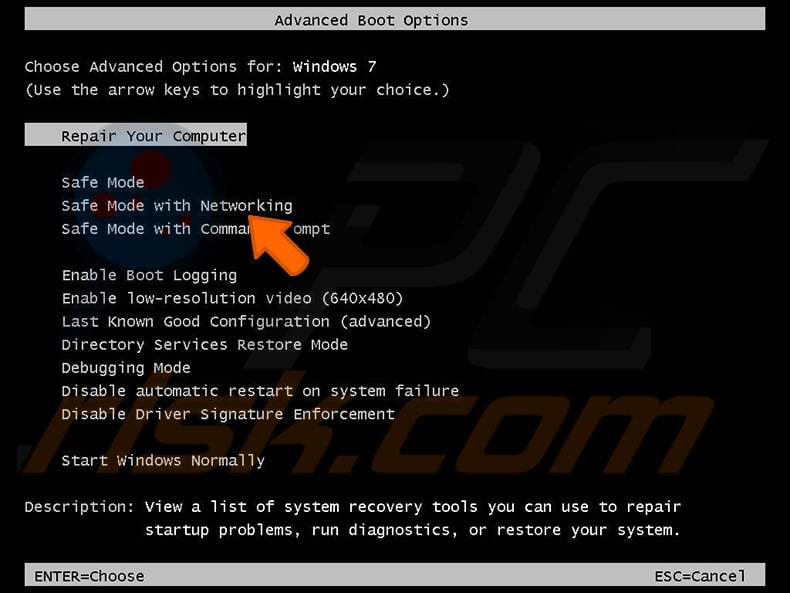
Video showing how to start Windows 7 in "Safe Mode with Networking":
Windows 8 users: Start Windows 8 is Safe Mode with Networking - Go to Windows 8 Start Screen, type Advanced, in the search results select Settings. Click Advanced startup options, in the opened "General PC Settings" window, select Advanced startup.
Click the "Restart now" button. Your computer will now restart into the "Advanced Startup options menu". Click the "Troubleshoot" button, and then click the "Advanced options" button. In the advanced option screen, click "Startup settings".
Click the "Restart" button. Your PC will restart into the Startup Settings screen. Press F5 to boot in Safe Mode with Networking.

Video showing how to start Windows 8 in "Safe Mode with Networking":
Windows 10 users: Click the Windows logo and select the Power icon. In the opened menu click "Restart" while holding "Shift" button on your keyboard. In the "choose an option" window click on the "Troubleshoot", next select "Advanced options".
In the advanced options menu select "Startup Settings" and click on the "Restart" button. In the following window you should click the "F5" button on your keyboard. This will restart your operating system in safe mode with networking.
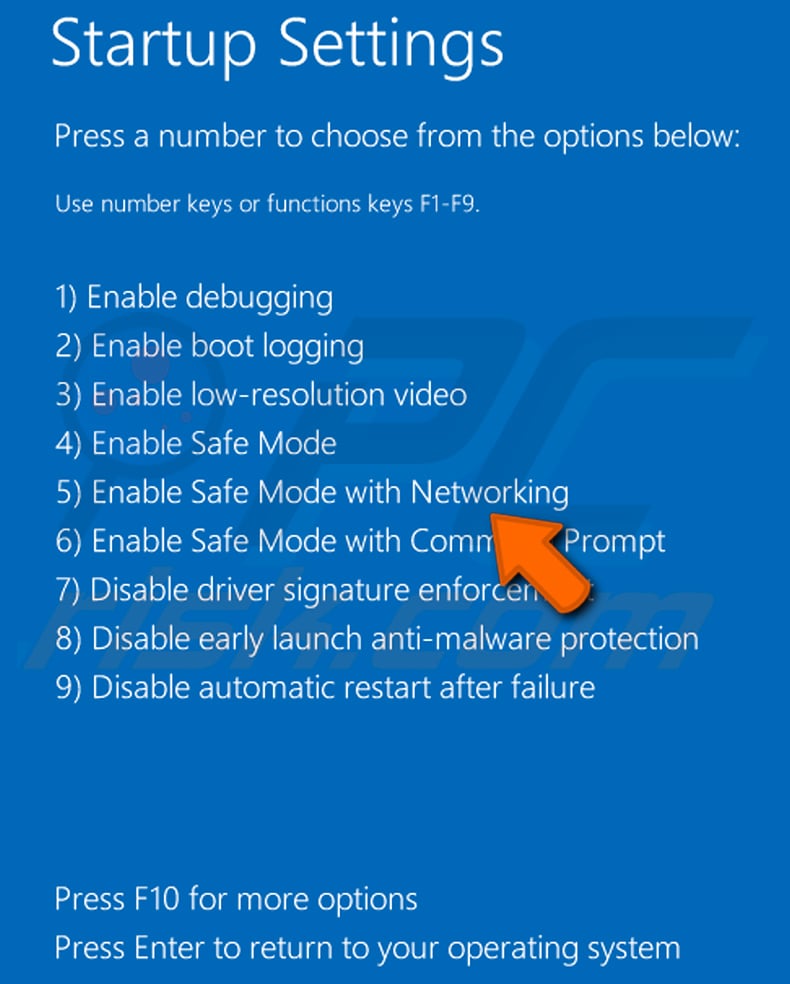
Video showing how to start Windows 10 in "Safe Mode with Networking":
 Extract the downloaded archive and run the Autoruns.exe file.
Extract the downloaded archive and run the Autoruns.exe file.

 In the Autoruns application, click "Options" at the top and uncheck "Hide Empty Locations" and "Hide Windows Entries" options. After this procedure, click the "Refresh" icon.
In the Autoruns application, click "Options" at the top and uncheck "Hide Empty Locations" and "Hide Windows Entries" options. After this procedure, click the "Refresh" icon.

 Check the list provided by the Autoruns application and locate the malware file that you want to eliminate.
Check the list provided by the Autoruns application and locate the malware file that you want to eliminate.
You should write down its full path and name. Note that some malware hides process names under legitimate Windows process names. At this stage, it is very important to avoid removing system files. After you locate the suspicious program you wish to remove, right click your mouse over its name and choose "Delete".

After removing the malware through the Autoruns application (this ensures that the malware will not run automatically on the next system startup), you should search for the malware name on your computer. Be sure to enable hidden files and folders before proceeding. If you find the filename of the malware, be sure to remove it.
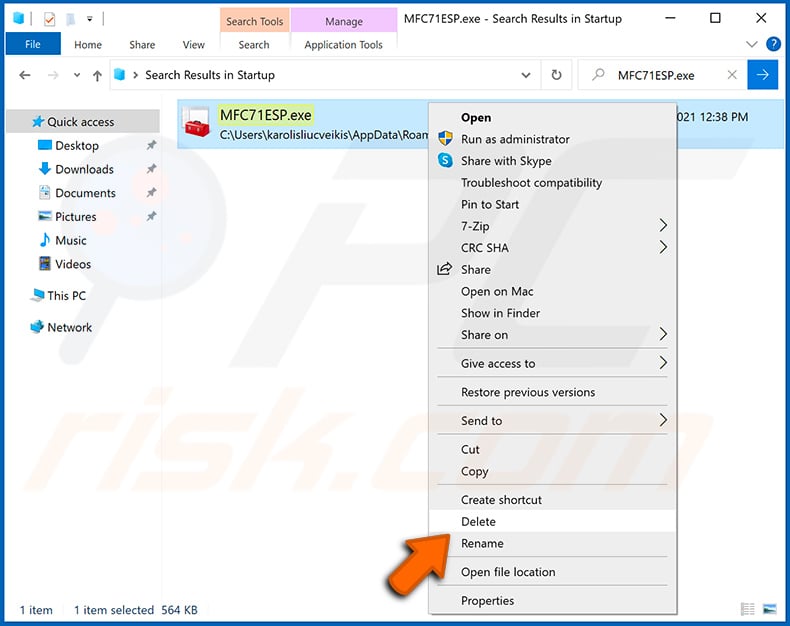
Reboot your computer in normal mode. Following these steps should remove any malware from your computer. Note that manual threat removal requires advanced computer skills. If you do not have these skills, leave malware removal to antivirus and anti-malware programs.
These steps might not work with advanced malware infections. As always it is best to prevent infection than try to remove malware later. To keep your computer safe, install the latest operating system updates and use antivirus software. To be sure your computer is free of malware infections, we recommend scanning it with Combo Cleaner Antivirus for Windows.
Frequently Asked Questions (FAQ)
My computer is infected with Eternidade malware, should I format my storage device to get rid of it?
Malware removal rarely necessitates formatting.
What are the biggest issues that Eternidade malware can cause?
The threats posed by a malicious program depend on its functionalities and the attackers' goals. Eternidade is a data-stealing malware that targets banking and other finance-related information. Generally, the presence of such software on devices can lead to severe privacy issues, financial losses, and identity theft.
What is the purpose of Eternidade malware?
Malware is primarily used for profit. However, cyber criminals can also use malicious software to disrupt processes (e.g., websites, services, companies, etc.), amuse themselves, exact vendettas, engage in hacktivism, and launch politically/geopolitically motivated attacks.
How did Eternidade malware infiltrate my computer?
Eternidade infiltrates systems alongside a WhatsApp worm that proliferates it via a malicious script sent to victims' contacts. Other distribution methods are possible.
Generally, malware is spread through trojans, drive-by downloads, dubious download sources (e.g., freeware and third-party websites, P2P sharing networks, etc.), malvertising, spam mail, online scams, illegal software activation ("cracking") tools, and fake updates. Some malicious programs can self-proliferate through local networks and removable storage devices.
Will Combo Cleaner protect me from malware?
Combo Cleaner is designed to scan devices and remove all kinds of threats. It is capable of detecting and eliminating most of the known malware infections. Remember that since sophisticated malware typically hides deep within systems – performing a full system scan is critical.
Share:

Tomas Meskauskas
Expert security researcher, professional malware analyst
I am passionate about computer security and technology. I have an experience of over 10 years working in various companies related to computer technical issue solving and Internet security. I have been working as an author and editor for pcrisk.com since 2010. Follow me on Twitter and LinkedIn to stay informed about the latest online security threats.
PCrisk security portal is brought by a company RCS LT.
Joined forces of security researchers help educate computer users about the latest online security threats. More information about the company RCS LT.
Our malware removal guides are free. However, if you want to support us you can send us a donation.
DonatePCrisk security portal is brought by a company RCS LT.
Joined forces of security researchers help educate computer users about the latest online security threats. More information about the company RCS LT.
Our malware removal guides are free. However, if you want to support us you can send us a donation.
Donate
▼ Show Discussion